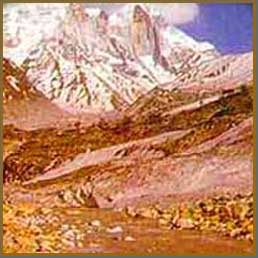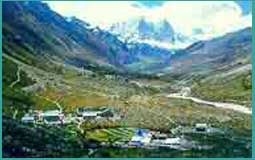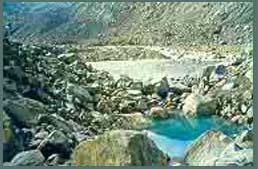| Pilgrim Places
| |||||||||||||||||||||||||||
This was my third attempt to trek in the Gangotri region. The previous two attempts found me on different paths, reaching destinations in the Himalayas that are beautiful in their own right but possibly missing the spiritual content of a pilgrimage. Failure to convince anyone about the need to visit the Gangotri region before the Gaumukh glacier recedes further, resulted in my making this trip alone. Being a normal family man with a school going daughter I was feeling terribly homesick by the time I reached Uttarkashi in the late afternoon of 13th September. The next day I was supposed to catch the first bus to Gangotri leaving Uttarkashi at 5:00 a.m. When I went to sleep, images of the terrible landslides that the Garhwal region experienced this year were on my mind. Sleep eluded me for the better part of the night. It started to pour from 3:00 a.m. When the bus left at 6:00 a.m. my spirits soared. Only to crash after 12 kilometers, facing a mudslide that had stopped all vehicles. Where the other drivers were content to wait for the Border Roads guys, our intrepid driver decided to use his engine power to overcome the mud. Ganga Mataji was kind, and the bus reached Gangotri around 2:00 p.m. A short walking distance from the bus stand is the temple, built 135 years ago by a family from Rajasthan. The clean surroundings are bound to impress everyone especially those from the plains. |
More on Uttarakhand • Overview • Uttarakhand Districts • Badrinath • Haridwar • Rishikesh • Char Dham • Mussoorie
Travelogues
Pilgrimages
Trekking | ||||||||||||||||||||||||||
The trek through some spectacular glacial 5.6 kilometers from Chirbasa is the valley of Bhojbasa. The path takes a sharp left turn and as you turn you see the small valley below you dotted with the GMVN rest house and the famous Lal Baba's Ashram. There is a picturesque campsite beside the river. The facilities at the GMVN rest house are not bad if one can ignore the baskets of used toilet paper in the Indian style toilets, which are strategically placed to ensure their proximity to your face as you sit down.
After about 2.5 kilometers the landscape becomes devoid of vegetation. The path takes you closer and closer along the riverbed. A little before the mouth of the glacier is a flat piece of land reminiscent of lunar landscape, with a small pond formed from rain water. The turquoise blue water, even under a grey overcast sky gives a surreal appearance to the scene. The actual sight of the mouth of the glacier is something of an anticlimax. Invariably the thought crosses your mind, whatever made them call this Gaumukh?
It was raining heavily and I saw mudslides coming from the top. Kishan shouted at me to hurry. I was walking on the crest of a rock formation barely 2 feet wide. The surface was a mixture of sand and rock and was showing a split, ready to break away. I somehow hurried across as the fear of coming back on this route gripped me. The path was like this for about 750 meters before turning right to cross the main glacier. I sat down on a rock to catch my breath. The rain beating down relentlessly on my face, I was aware of the sheer exhaustion I felt.
At the end of it you realise that it is not crossing the crevasses that is difficult, but knowing your way around them that makes the difference between a rewarding experience and a harrowing, tedious one. Gradually we crossed the last of the crevasses to reach the base of Tapovan. It is a short, steep climb. My estimate is that in less than a kilometer one climbs more than 2000 feet. Slowly we made our way up, initially walking 50 steps followed by 5 minutes of rest, finally slowing down to10 steps with 10 minutes rest.
There is no organised accommodation at Tapovan. Most trekkers carry their own tents and supplies. Simla Baba offers basic facilities to travellers. Payment is optional and is never insisted on. Being alone, I elected to seek refuge at Simla Baba's Ashram. Simla Baba has been meditating at Tapovan for close to 35 years now. Failing health now compels him to descend to more habitable, hospitable terrain during the harsh winter. The rain had stopped by now and by mid afternoon I caught the first glimpse of the Bhagirathi range of three peaks, known as the Bhagirathi sisters. A little later, the majestic Shivling became visible. It is impossible to express the sheer beauty of the place with the awe-inspiring peaks in the background. They remain in your consciousness long after you return from Tapovan to your daily life. |
|||||||||||||||||||||||||||
Editor: Romola Butalia (c) India Travelogue. All rights reserved. |
|||||||||||||||||||||||||||

 moraines in the Himalayas is a visual delight. The greenery thins out within the first few kilometers out of Gangotri only to reappear near Chirbasa. The tea stops en route to Bhojbasa are reasonably well stocked. Most trekkers skip the first two stalls at 3.5 and 4.5 kilometers preferring to spend time at Chirbasa, 9 Kilometers from Gangotri. Chirbasa is still thickly wooded but the large number of stalls here takes something away from the charm of the place. From Chirbasa the landscape becomes more barren and one begins to feel the effect of altitude for the first time. A word of advice: Try to spend at least a full day each at Gangotri and at Bhojbasa if you intend to trek to Tapovan. I overlooked this and suffered some discomfort at Tapovan.
moraines in the Himalayas is a visual delight. The greenery thins out within the first few kilometers out of Gangotri only to reappear near Chirbasa. The tea stops en route to Bhojbasa are reasonably well stocked. Most trekkers skip the first two stalls at 3.5 and 4.5 kilometers preferring to spend time at Chirbasa, 9 Kilometers from Gangotri. Chirbasa is still thickly wooded but the large number of stalls here takes something away from the charm of the place. From Chirbasa the landscape becomes more barren and one begins to feel the effect of altitude for the first time. A word of advice: Try to spend at least a full day each at Gangotri and at Bhojbasa if you intend to trek to Tapovan. I overlooked this and suffered some discomfort at Tapovan.
 Like the previous night at Gangotri, sleep eluded me again at Bhojbasa. An added bonus was a splitting headache. I left my bed around 4:00 am, numb with cold and distinctly miserable. The gloomy weather did nothing to cheer my spirits, and by 6 a.m. a moderate drizzle ensued. With Kishan in tow, I started the day's climb at 7:00 a.m. The drizzle turned to mild rain as I climbed out of the Bhojbasa valley.
Like the previous night at Gangotri, sleep eluded me again at Bhojbasa. An added bonus was a splitting headache. I left my bed around 4:00 am, numb with cold and distinctly miserable. The gloomy weather did nothing to cheer my spirits, and by 6 a.m. a moderate drizzle ensued. With Kishan in tow, I started the day's climb at 7:00 a.m. The drizzle turned to mild rain as I climbed out of the Bhojbasa valley.
 With your mind focused on the source of the sacred Ganga and the layers of blue ice that form the roof of this gigantic ice cave you trek slowly ahead. Suddenly you discover that it is very quiet. You can no longer hear the river, and an eerie silence engulfs you. Your porter tells you that you are on the Gangotri glacier. The path rises above the river bed and one has to trek close to the sheer rock face on the right bank of the river from where the glacier starts.
With your mind focused on the source of the sacred Ganga and the layers of blue ice that form the roof of this gigantic ice cave you trek slowly ahead. Suddenly you discover that it is very quiet. You can no longer hear the river, and an eerie silence engulfs you. Your porter tells you that you are on the Gangotri glacier. The path rises above the river bed and one has to trek close to the sheer rock face on the right bank of the river from where the glacier starts.
 Looking ahead of me I saw the end of the path not far away from where I stood panting for breath. A few laboured steps and I was on flat ground. Quite suddenly, I was stunned by what emerged through the mist. All my tiredness vanished as I stood in an enchanted trance. Ahead of me was the holy Tapovan, where sages and ascetics have meditated for ages. It was larger than a few hundred soccer fields with a small stream meandering its way through the multi-coloured shrubs.
Looking ahead of me I saw the end of the path not far away from where I stood panting for breath. A few laboured steps and I was on flat ground. Quite suddenly, I was stunned by what emerged through the mist. All my tiredness vanished as I stood in an enchanted trance. Ahead of me was the holy Tapovan, where sages and ascetics have meditated for ages. It was larger than a few hundred soccer fields with a small stream meandering its way through the multi-coloured shrubs.